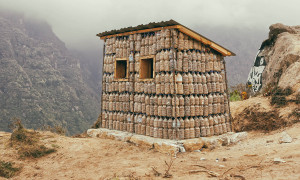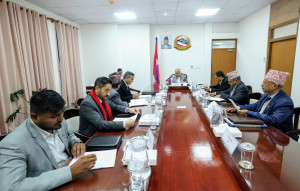Money
Nepal’s key gateway to global trade set for Rs397 million makeover
The Rs396.9 million upgrade, backed by the World Bank, will expand capacity at Nepal’s largest dry port in Birgunj with new infrastructure including warehouses, parking, and firefighting systems after years of congestion and local protests.Shankar Acharya
After more than 20 years, the long-awaited expansion of Sirsiya Dry Port in Birgunj—Nepal’s first and largest inland trade gateway—has finally begun. The project is backed by an investment of Rs396.9 million and support from the World Bank.
According to Ashish Gajurel, executive director of the Nepal Intermodal Transport Development Board, the infrastructure upgrade is part of the World Bank's Strategic Road Connectivity and Trade Improvement Project.
"The project includes construction of a warehouse, expanded parking space, a firefighting system, a weighbridge, restrooms for drivers, and additional facilities,” he said. “This expansion is being implemented through a soft loan from the World Bank, which had also financed the original construction two decades ago.”
Operational since 2004, the Sirsiya Dry Port spans 38 hectares and can accommodate up to 1,586 containers.
However, over time, increasing trade volume has strained its capacity, leaving operators struggling to manage container traffic beyond its design limits.
Linked directly to the Indian railway network, the dry port facilitates the import and export of goods through Indian seaports in Kolkata, Haldia, and Visakhapatnam. Key imports include sugar, fertiliser, iron and steel, and coal, primarily from India.
The dry port is operated under a public-private partnership model. For the first 15 years, Himalayan Terminal Company managed operations. Currently, Pristine Valley Company holds the operational contract for a five-year term.
With trade volume steadily rising, local business leaders have called for urgent infrastructure upgrades. Madhav Rajpal, senior vice-president of the Birgunj Chamber of Commerce and Industry, emphasised the growing need for expansion.
“Container traffic has grown significantly, and the port area is becoming increasingly congested,” he said. “The government must expedite the land acquisition process for the 62 bighas between the dry port and the Integrated Check Post (ICP). Expansion in that area is crucial.”
Hari Gautam, president of the Birgunj Chamber of Commerce and Industry, echoed these concerns. “Despite being Nepal’s busiest and first dry port, the facility still lacks basic infrastructure,” he said. “We've consistently lobbied for development and expansion. The federal government needs to prioritise the upgrade, which is vital for boosting trade, especially with third countries.”
According to port officials, congestion at the facility has begun to affect its ability to handle new shipments. Goods entering Nepal typically arrive via two routes in Birgunj: the Sirsiya Dry Port and the Integrated Check Post. While railway rakes deliver cargo to the dry port, trucks cross the border through the ICP.
On an average day, the ICP handles more traffic than the dry port and generates nearly four times more revenue.
The dry port's expansion has also sparked local tensions. In March 2023, residents of Birgunj-25, Sirsiya, staged a sit-in protest at the port’s main gate.
They demanded compensation for their land, which the government had earmarked for acquisition over six years ago, but for which no payment had been made. The government plans to acquire 41 hectares of land situated between the Sirsiya Dry Port and the ICP to facilitate the port's expansion.
Traders along the Birgunj–Pathlaiya Industrial Corridor rely heavily on the dry port.
The direct railway connection allows them to bypass the risks and bureaucratic hurdles associated with road transport.
Transporting goods via cargo trucks from Kolkata carries the risk of theft and requires importers to pay taxes in each Indian state en route, making railway imports a more secure and cost-effective option.
The long-overdue expansion project will ease congestion, improve trade logistics, and strengthen Nepal’s commercial connectivity with India and third-country markets.




 17.12°C Kathmandu
17.12°C Kathmandu















